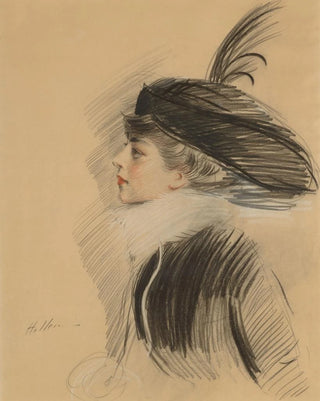Art print | Portrait of Belle da Costa Greene - Paul César Helleu


View from behind

Frame (optional)
In the fascinating world of art, some works transcend the mere frame to become timeless witnesses of elegance and human beauty. The "Portrait of Belle da Costa Greene" by Paul César Helleu stands out for its undeniable charm and its ability to capture the essence of a bygone era. This painting, depicting a woman with exquisite grace, immerses us in the refined atmosphere of the early 20th century, where art and fashion intertwined harmoniously. Through this portrait, Helleu invites us to explore not only the figure of Belle da Costa Greene but also the soul of a time marked by the pursuit of beauty and aesthetics.
Style and uniqueness of the work
Paul César Helleu's style is characterized by a delicacy and lightness that are uniquely his own. In the "Portrait of Belle da Costa Greene," the finesse of lines and the softness of colors combine to create a dreamlike atmosphere. Helleu excels in the use of pastels, a technique that allows him to bring to life portraits imbued with sensuality and refinement. Each brushstroke seems to caress the canvas, revealing not only the features of his model but also a rare emotional depth. The way he plays with light, subtly illuminating Belle's face, highlights her natural elegance and mysterious allure. This portrait is not merely a representation but a true ode to feminine beauty, where every detail is carefully thought out to evoke a sense of softness and grace.
The artist and his influence
Paul César Helleu, born in 1859, is one of the most influential artists of his time. Recognized for his portraits of elegant women and scenes of Parisian life, Helleu managed to establish himself in the artistic world thanks to his unique style and mastery of painting techniques. His work is often associated with Art Nouveau, a movement that values aesthetics and harmony of forms. Helleu also mingled with emblematic figures such as Marcel Proust and members of high society, which allowed him to capture the very essence of the aristocracy of his era.

Matte finish

View from behind

Frame (optional)
In the fascinating world of art, some works transcend the mere frame to become timeless witnesses of elegance and human beauty. The "Portrait of Belle da Costa Greene" by Paul César Helleu stands out for its undeniable charm and its ability to capture the essence of a bygone era. This painting, depicting a woman with exquisite grace, immerses us in the refined atmosphere of the early 20th century, where art and fashion intertwined harmoniously. Through this portrait, Helleu invites us to explore not only the figure of Belle da Costa Greene but also the soul of a time marked by the pursuit of beauty and aesthetics.
Style and uniqueness of the work
Paul César Helleu's style is characterized by a delicacy and lightness that are uniquely his own. In the "Portrait of Belle da Costa Greene," the finesse of lines and the softness of colors combine to create a dreamlike atmosphere. Helleu excels in the use of pastels, a technique that allows him to bring to life portraits imbued with sensuality and refinement. Each brushstroke seems to caress the canvas, revealing not only the features of his model but also a rare emotional depth. The way he plays with light, subtly illuminating Belle's face, highlights her natural elegance and mysterious allure. This portrait is not merely a representation but a true ode to feminine beauty, where every detail is carefully thought out to evoke a sense of softness and grace.
The artist and his influence
Paul César Helleu, born in 1859, is one of the most influential artists of his time. Recognized for his portraits of elegant women and scenes of Parisian life, Helleu managed to establish himself in the artistic world thanks to his unique style and mastery of painting techniques. His work is often associated with Art Nouveau, a movement that values aesthetics and harmony of forms. Helleu also mingled with emblematic figures such as Marcel Proust and members of high society, which allowed him to capture the very essence of the aristocracy of his era.






